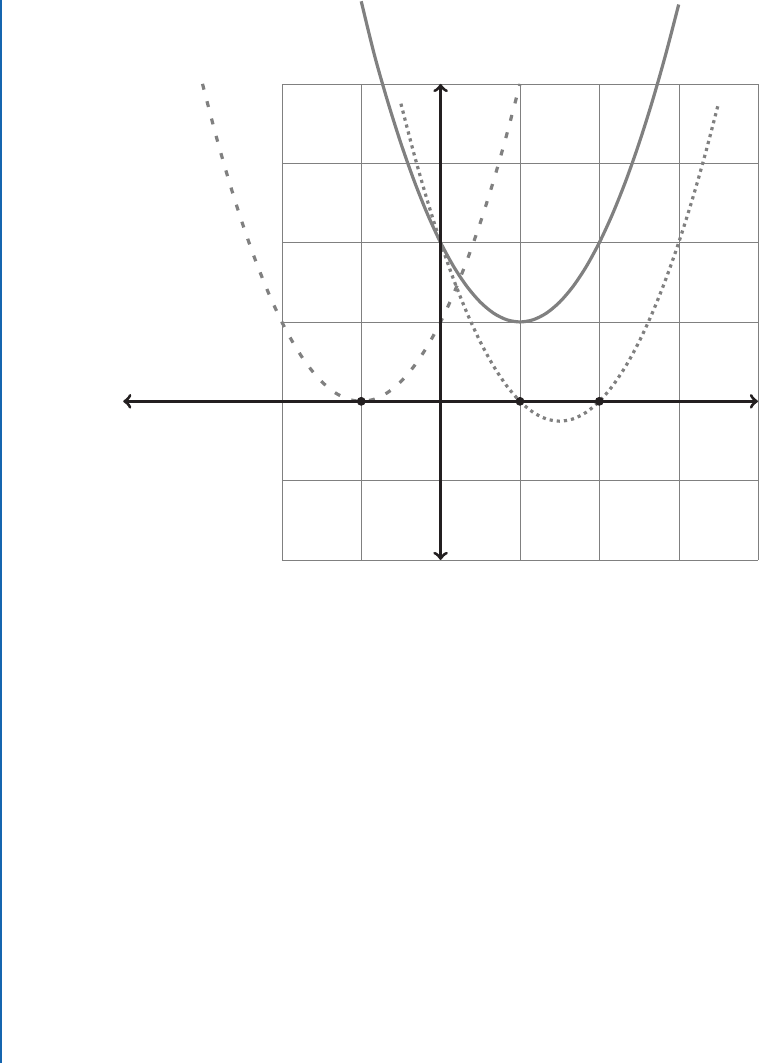
1.3. QUADRATIC EQUATIONS 19
y D 4
y D 2
x D 4x D 2
x=2x=1
Figure 1.5: e equation x
2
3x C 2 D 0 has roots at x D 1; 2.
1.3.1 FACTORING A QUADRATIC
e simplest method of solving a quadratic equation is to factor it. If the equation has no roots,
then it won’t factor. A quadratic equation with one root is a perfect square of one term of the
form .x a/, possibly multiplied by a constant. When a quadratic has two roots, it factors into
two different terms. Let’s look at some examples of quadratics that factor:
Example 1.44
x
2
3x C 2 D .x 1/.x 2/
x
2
9 D .x 3/.x C 3/
x
2
8x C 15 D .x 5/.x 3/
x
2
C 4x C 4 D .x C 2/.x C 2/
x
2
x 2 D .x 2/.x C 1/
2x
2
C 3x C 1 D .2x C 1/.x C 1/
.Ax C B/.Cx C D/ D ACx
2
C .AD C BC /x C BD
˙

20 1. REVIEW OF ALGEBRA
y D 4
y D 2
x D 4x D 4
Figure 1.6: Quadratic equations with 0, 1, or 2 roots.
e last line of Example 1.44 is a generic factorization.
e rules for factors:
1. e product of the two constants must be the constant term of the quadratic.
2. Adding the results of multiplying the number in front of x in one term by the constant in
the other term must be the number in front of x in the quadratic.
3. e product of the numbers in front of the x’s must be the number in front of x
2
in the
quadratic.

1.3. QUADRATIC EQUATIONS 21
So, for example, x
2
3x C 2 D .x 1/.x 2/ uses the facts that .1/.2/ D 2 and 1 2 D
3 to tell us that the factors are .x 1/ and .x 2/, which makes the roots 1 and 2. If .x a/
is a factor of a quadratic, then a is a root of the quadratic.
Example 1.45 Factor x
2
7x C 12 D 0, but first plug in x D 3.
Solution:
We plug in x D 3 and get that 9 21 C 12 D 0. So plugging in 3 makes the quadratic
zero. is means:
x
2
7x C 12 D .x 3/.x‹/
But 12/3=4 so ‹ D 4 is a good guess. Let’s check:
.x 3/.x 4/ D x
2
3x 4x C 12 D x
2
7x C 12;
and we have the correct factorization.
˙
e preceding example used a trick—plugging in 3—to locate one of the factors of the quadratic.
Let’s make this a formal rule in Knowledge Box 1.10. In general we don’t plug in 3, we plug in
things that might work. Factors of the constant terms are usually good guesses—remember that
they can be positive or negative.
Knowledge Box 1.10
Suppose that f .x/ is a quadratic equation and that f .c/ D 0 for some
number c. en .x c/ is a factor of f .x/.
Example 1.46 Factor x
2
2x 8 D 0.
Solution:
e number 8 factors into 1 8 and 2 4. Since 4 2 D 2 and the middle term is 2x,
the factorization is probably .x ˙ 2/.x ˙ 4/. Since we have 8, one needs to be positive, and
the other needs to be negative. To get a 2x we need to subtract 4x and add 2x. is means
the factorization must be:
x
2
2x 8 D .x 4/.x C 2/
˙
..................Content has been hidden....................
You can't read the all page of ebook, please click here login for view all page.
